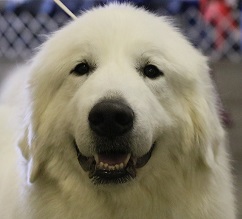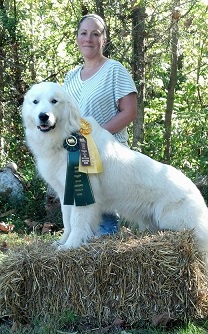The Great Pyrenees
These dogs take their name from the mountain range in southwestern Europe, where they have long been used as guardians of the flocks. In the United States they are called Great Pyrenees. In the United Kingdom and on the continent of Europe, they are known as the Pyrenean Mountain Dog. In their native France, they are Le Chien de Montagne des Pyrenees or Le Chien des Pyrenees. Whatever the name, it is a beautiful white dog with a "certain elegance" which for centuries has been the working associate of peasant shepherds high on the mountain slopes; the dog was "discovered" by French nobility in the seventeenth century and elevated to the status of court dog of France.
While it is generally accepted that no living breed of dog can be traced back to its wild form, and that what is known about dogs of any sort prior to a century or two ago is so little, these dogs are believed to have migrated into Europe from Asia Minor, moving westward and leaving kin in all the prominent mountain valleys of Europe. These later developed individual characteristics in the seclusion of their own environment and came to be known as the Maremma, Kuvasz, Polish Tatra, Akbash, Slovakian Chuvach, and others.
Excerpted from "Great Pyrenees" copyright 2015 The Great Pyrenees Club of America

Click here to view an Interactive Breed Standard.
The complete AKC Breed Standard can be found here.
The Great Pyrenees originated in the Pyrenees mountains of Europe which form the border between France and Spain. They were developed by the Basque people to protect their flocks from predation by bears and wolves. The dogs have been used for this purpose for over a thousand years. Since a lot of the bears and wolves have disappeared from the mountains, the dogs today are still guarding homes and property. Historically, the dogs have also been used in France to guard large estates. The ability of these dogs to work was achieved by selective breeding in which only the most successful workers were allowed to reproduce themselves, and therefore, a great deal of this inbred instinct remains strong. It is upon this thousand-year selection that we draw when we breed modern dogs for working purposes.
The Great Pyrenees is a territorial guard by nature, which means that he works to keep his territory free from predatory danger. Because of this, there may be times when the shepherd does not see the dog for long periods of time. He knows that the job is being done because the losses decrease. If the dog is working effectively, the stockman may never see a predator, and the flock will never be disturbed.
A good working dog has been selected for hostility toward all possible predators. This is why Great Pyrenees, although bred to work on bears and wolves, are equally effective on wild and feral dogs which are an increasing problem to stockman. By nature, the Great Pyrenees is nocturnal. It has no tolerance for other dogs except the herding dogs that it works with, and very small dogs. It can be trusted with small, young and helpless animals of any kind, but it has to be watched as a young pup with some supervision as it usually takes a pup 18 months to become a livestock guardian dog. It is one of the most interesting qualities of a Great Pyrenees-the absolute intolerance of all predators, coupled with extraordinary patience and kindness to stock.
If you have purchased your pup to be a farm or ranch guardian dog and would like more information or assistance with your pup, visit the Great Pyrenees Club off America website.
Excerpted from the GPCA web site "Livestock Guardian" page copyright 2017 The Great Pyrenees Club of America

Great Pyrenees owners need to keep in mind the traditional role that Pyrenees were bred to fulfill: that of flock guardian. Pyrenees roamed the mountains with their flocks, and had to be alert to danger. Intelligence, independence, and physical toughness were prized. Flock guardians also needed to be still most of the time (so as not to spook the sheep) while being able to explode into quick action in defense of their charges. While each dog is an individual, these common breed traits have implications for trainers. With patience and a gentle touch, Great Pyrenees can be trained to compete in many different venues. Great Pyrenees are very intelligent dogs, but they become bored very quickly. So, owners should keep training sessions short - no more than a few minutes a piece, and avoid drilling a task or exercise. |

